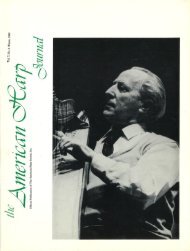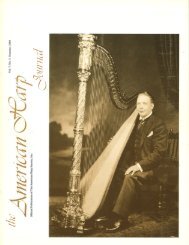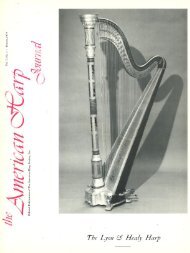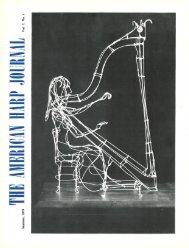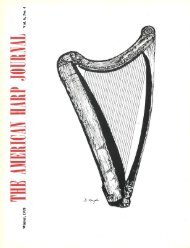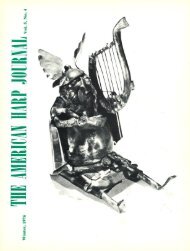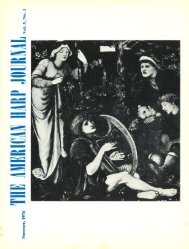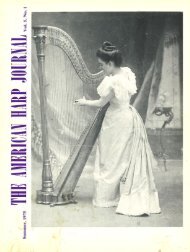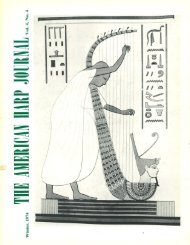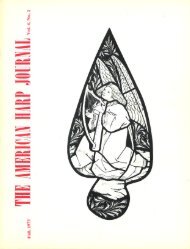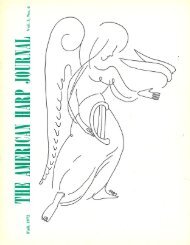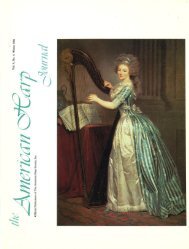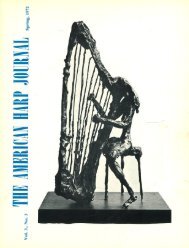AHJ, Vol. 2 No. 1, Spring 1969
AHJ, Vol. 2 No. 1, Spring 1969
AHJ, Vol. 2 No. 1, Spring 1969
Create successful ePaper yourself
Turn your PDF publications into a flip-book with our unique Google optimized e-Paper software.
lJnde1·standing<br />
The Stt1dent<br />
Harpist<br />
by Marjorie Chauvel<br />
This article by Miss Chauvel appeared first in the<br />
May 1968 issue of The Instrumentalist, and is reprinted<br />
with the permission of that publication.<br />
Copyright 1968 by The Instrumentalist. Used by<br />
permission.<br />
The student harpist is often the enfant terrible<br />
of the orchestra; the conductor can't<br />
live with her, or without her. Perhaps I can<br />
explain some of the reasons for the difficulties<br />
and misunderstandings which arise<br />
in dealing with the young orchestra harpist.<br />
The professional harp teacher is frequently<br />
asked by conductors and music educators<br />
if the harp is really such a difficult instrument<br />
to play. This question is usually<br />
prompted by the repeated problems that<br />
arise with the use of a young, inexperienced<br />
harpist in an orchestra. Actually, it is probably<br />
no more difficult than any other instrument,<br />
but its problems are a little different<br />
and not understood by many. Let us<br />
discuss the problem of tension first. The<br />
harp student, like others, experiences the<br />
usual tension during performance; however,<br />
its source is different than that of other instrumentalists.<br />
The harp student rarely has<br />
the opportunity to be exposed to and participate<br />
in section training, and it is all too infrequent<br />
that she has the chance to play<br />
with other harpists. On the other hand, the<br />
young violinist can go into the orchestra<br />
and sit in the back of the section until, as<br />
experience makes him more competent, he<br />
is able to work up and assume more responsibility.<br />
However, it is rare for a young<br />
harpist to go into an orchestra where there<br />
4<br />
is another sitting in front, helping to train<br />
her. Usually she is alone, exposed, and playing<br />
in a solo capacity.<br />
Another of the student harpist's problems<br />
is her inability to count and lack of<br />
knowledge of musical notation. Although<br />
she has few notes to play, this does not necessarily<br />
make her part any easier. Counting<br />
for several hundred bars and suddenly<br />
e~ec~ing oneself into a rhythm can be more<br />
difficult than playing every bar. Frequently,<br />
she is looking at a part that is completely<br />
foreign to her, with unfamiliar musical notation,<br />
which, if not properly explained,<br />
can look like another language. There is<br />
also a three-way visual problem. Most instrumentalists<br />
can line up their music and<br />
the conductor while barely having to look<br />
at their instruments to play. But the harpist<br />
has to look at her music, her instrument,<br />
and finally, the conductor; not an easy task<br />
when she is learning to feel intervals and<br />
count. For years I was baffled by students<br />
who would say that "the conductor keeps<br />
telling me that I'm not looking at him and<br />
I am!" I finally realized that they were<br />
looking from the corner of their eye, but the<br />
conductor had difficulty realizing this.<br />
Another complaint about the young harpist<br />
is that she plays too softly. There are<br />
many reasons for this; it takes many years<br />
before the harpist is capable of playing<br />
loudly as a natural approach. First, the<br />
timidness usually comes from a lack of confidence<br />
and strength. The fingers need to<br />
be trained for many years before sufficient<br />
strength is built up in them, as well as in the<br />
shoulder and back muscles. Until that time<br />
playing too loudly would only result in ~<br />
forced and, consequently bad tone. Like other<br />
young musicians, the harpist frequently<br />
thinks she can be heard simply because she<br />
can hear herself. So the placement of the<br />
harp within the orchestra is extremely important<br />
for bringing out the tone. The best<br />
position for the harp is as far forward as<br />
possible and within the string section. Then<br />
too, the orchestra directors, in elementary<br />
schools particularly, must remember that a<br />
small harp cannot possibly produce the tone<br />
of a full-sized concert instrument. A good<br />
way to surmount this problem is to use two<br />
harps. It is also wise for the conductor to<br />
tell the young harpist to play without worrying<br />
about the possibility of playing a<br />
AMERICAN HARP JOURNAL




